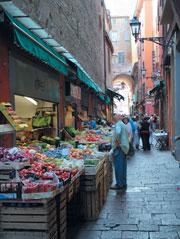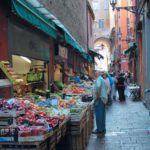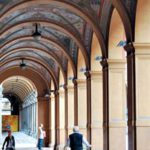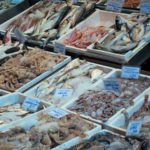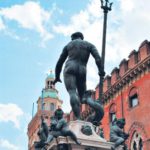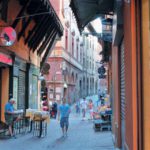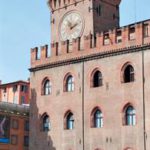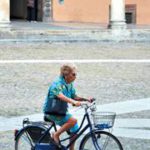One of Italy’s best-kept secrets is Bologna, situated in the heart of Emilia-Romagna. Bologna boasts Europes second largest historic centre (after Venice) and the city has long been known as La Grassa (The Fat One) for its reputation as one of Italy’s food capitals
PAUL MACIEL
Bologna is often overlooked by tourists because it doesn’t hold the same level of appeal as its neighbours Florence and Venice, or other major Italian destinations. While the city may not boast the extensive collections of Renaissance art of Florence, or Venice’s waterways, it offers a great deal for lovers of food, art and shopping. Home to Europe’s oldest university (founded in 1088), the city has always attracted great intellectuals, giving it both a prestigious and relaxed atmosphere.
Past students and residents include Dante, Petrarch and Copernicus. As with most towns of Roman design the city follows a traditional layout with the main roads coming off its central piazzas – Piazza Maggiore and Piazza Nettuno. Piazza Maggiore is dominated by the impressive Duomo of San Petronio. Originally intended to be bigger than St Peter’s in Rome, the Duomo’s transepts were left off the church on the orders of Pope Pius IV, reducing its size and protecting St Peter’s reputation as Italy’s grandest cathedral.
The city is most famous for its thousands of wide marble arcades (porticoes) that line nearly every main street, running to more than 37 kilometres throughout the city. The porticoes offer a welcome relief from the heat of a summer’s day and a safe escape from mad Italian students and residents on Vespas and bicycles. The Portico of San Luca links the city to the Sanctuary of the Madonna of San Luca via a spectacular arcade of more than 666 porticoes – the longest in the world.
Although it is a great walk, you may begin to feel a little less inspired by the time you reach portico number 300, so take the bus from Via Saragozza. The Sanctuary of the Madonna of San Luca contains the work of several masters. The Madonna and Child, attributed to Luke the Evangelist, is seen as one of its most important. For those seeking more art and culture there is also a plethora of breathtaking museums to choose from. Pinacoteca Nazionale displays art dating from 1200 to 1800 and features the work of Giotto, Raphael, Titian and Tintoretto, among others. Morandi Museum focuses primarily on the work of Giorgio Morandi and includes more than 250 of his works.
The Collezioni Comunale d’Arte is also worth a visit. Located in the Palazzo Communale, the furnished halls contain furniture, artworks, decorations and murals produced from the 14th to the 19th century. Enquire at the tourist office about the Bologna Museum card available as a three- or five-day pass; it’s the best way to enjoy all the art at a fraction of the price.
The city’s ancient skyline was once littered with soaring towers built by proud (if slightly egotistical) noble families. Many of the towers have since fallen, but two of the most famous towers, Garisenda and Asinelli, are still standing. For something a little different visit La Torre dei Prendiparte (www.prendiparte.it), a bed-andbreakfast establishment that sometimes opens its rooftop for tours and even for music concerts. Be warned, this is not for the faint-hearted: the 11-storey climb is vertigo-inducing but the payoff is extraordinary.
Something few visitors realise is that underneath the city’s cobblestone streets lies a medieval network of canals, originally used for trade and transport. Most have long since been paved over, but for a great look at what lies beneath, go to 16 – 18 Via Piella where you can catch a glimpse over a gushing stream. Just a block away at Caffè Opera e Tulipani (on Via Alessandrini), get a table in the back room overlooking a rushing waterfall – you would be forgiven for wondering whether you were in Bologna or Venice.
What would a trip to Italy be without shopping? Follow Via dell’Archiginnasio, running to the left of Duomo San Petronio, to the ultimate shopper’s paradise, Galleria Cavour. This street includes all the finest boutiques: Max Mara, Prada, Louis Vuitton, Cartier, La Perla, Tod’s, Bruno Magli, Gucci… the list goes on. In the middle of this strip on Piazza Galvani is Bologna’s grand caffè, Zanarini. This is the place where the city’s wellheeled residents hang out and enjoy coffee, snacks and aperitivi.
Cool down and treat yourself to a cappuccino and a delicious pastry in the shade of the Duomo. For less bank-breaking shopping head down the main street, Via Indipendenza for great high street names. Don’t miss some of the stores on Via Ugo Bassi, including Coin, Max Mara and Furla. For lovers of homeware, check out the fourth floor of Coin Casa, which offers everything from innovative coffee machines to nifty gadgets.
Bologna is a city that takes its cuisine seriously. It has given the world many great dishes, including lasagne, mortadella, tortellini and Bolognese sauce. There is no shortage of great restaurants, ranging from student-friendly trattorias to exquisite Slow Food-rated restaurants. If you are staying in an apartment and fancy doing some of your own cooking, there are plenty of supermarkets in the city. There are also several fresh produce markets throughout the week. The selection of fruit, vegetable and fish is incredible and always absolutely fresh, but make sure you get there early because the locals descend on Via Drapperie and everything disappears quickly. Another great street for food is Via Clavature – try Ristorante Clavature for the best Bolognese ragu with fresh homemade parpadelle. There are also some incredible salumerie (delis) in this strip of stores.
The smells and sheer range of products available are almost overwhelming. A must-see deli is A.F. Tamburini (www.tamburini.com). This institution has served local residents for more than 100 years and the offerings are simply exquisite. It features mounds of handmade fresh pasta, especially the local speciality, tortellini. For a sweet treat head down Via Santo Stefano and hunt down the Cremaria Santo Stefano, one of the city’s artisan gelateria/ciocolateria. At this little hole in the wall, they produce the finest hot chocolate in winter, crafted from Creolo chocolate and fresh cream and topped with farm-fresh mascarpone cream – true indulgence. They’ve also found a way of suspending these awesome ingredients in the most decadent chocolate ice cream I have ever tasted.
Bologna hosts many of Italy’s biggest trade fairs, ranging from food to fashion and industry. So while there is no shortage of hotels they are often only available at prime prices; at certain times of the year they are fully booked. Out of trade fair season there are loads of great specials to be had. Many of the hotels can be found around the train station, which has a slightly industrial feel – if possible, try to locate a hotel in the heart of the historic centre.
GETTING THERE AND AROUND
• The most picturesque way to visit Bologna is to fly to Florence Pretola Airport and to rent a car. (Swiss Air offers the quickest and most direct flight with a 40-minute stopover and short connection.) From the airport it’s a short 70-minute drive through beautiful towns and mountains to reach the city. Air France and KLM fly directly to Bologna International Airport.
• Parking is generally easily available in Bologna but check where you are staying to ensure you have something easily accessible.
• Use Bologna as a base and visit the nearby towns of Modena, Parma and Rimini.
• For more information visit www.homelidays. com; www.hrs.com; www.swiss.com; www.bolognaarthotels.it; www.unahotels.it; or www.albergodrapperie.com.
SOURCES
PAUL MACIEL

